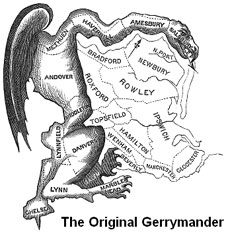Article I Section 2 Clauses 3, 4, 5
[3] [Representatives and direct Taxes shall be apportioned among the several States which may be included within this Union, according to their respective Numbers, which shall be determined by adding to the whole Number of free Persons, including those bound to Service for a Term of Years, and excluding Indians not taxed, three fifths of all other Persons.]* The actual Enumeration shall be made within three Years after the first Meeting of the Congress of the United States, and within ever subsequent Term of ten Years, in such Manner as they shall by Law direct. The Number of Representatives shall not exceed one for every thirty Thousand, but each State shall have at Least one Representative and until such enumeration shall be made, the State of New Hampshire shall be entitled to chuse three, Massachusetts eight, Rhode-Island and Providence Plantations** one, Connecticut five, New-York six, New Jersey four, Pennsylvania eight, Delaware one, Maryland six, Virginia ten, North Carolina five, South Carolina five, and Georgia three.
[4] When vacancies happen in the Representation from any State, the Executive Authority thereof shall issue Writs of Election to fill such Vacancies.
[5] The House of Representatives shall chuse their Speaker and other Officers; and shall have the sole Power of Impeachment.
*changed by the 14 amendment, section 2
** did you know this is the official name of Rhode Island, well now you do.
This part of the grand document sets out how many Reps will come from each state, and lays out how they will be chosen (one for every 30,000 people). It also lays out that a census should be taken every ten years, and that that number will be used to pick how many Reps a state gets. It gives the house the sole power of impeachment, and contains the infamous “three-fifths” compromise, later abolished by the 13-14-15 amendments.
Incidentally the term gerrymandering (the practice of drawing up districts so they contain all the votes most likely to vote for one party over another) comes from the efforts of Massachusetts Republicans to apportion legislative districts to favor their party in 1812. The name of the governor was Elbridge Gerry which a political cartoonist combined with the image of the mythical beast salamander to portray what the crazy districts lines looked like. Hence the Gerrymander.

This section lays out what each of the original states will have for Representatives, but does not draw the lines for the districts. That power is left to the states.
If a member of the house dies or resigns midterm the governor of that state can call for a special election, with a “writ of election” to fill that seat. Unlike the Senate where a governor can appoint a replacement no member of the house has ever served without being elected.
These clauses also authorizes the House to elect its own Speaker. The Speaker presides over its meetings or appoints another member to do so. By act of Congress the Speaker is next in line to become president if both the President and VP and unable to serve.
The power of impeachment (think of it as an indictment) requires only a simple majority in the House. A two-thirds vote in the Senate is then required to convict and remove from office the impeached official. If a president is impeached the chief justice of the United States presides over the trial in the Senate, not the VP as the VP has too much to gain and could be swayed.